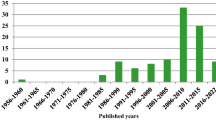Abstract
Urban populations of Canada geese, Branta canadensis, pose a nuisance problem throughout most of the eastern United States and in other parts of the United States and Canada. Puccinellia arctica is a species of arctic grass that is unpalatable to Canada geese on the North Slope of Alaska and may prove to be an effective long-term and nonlethal means of controlling the growing populations of urban Canada geese. A comparative study of the secondary metabolites of both P. arctica and Puccinellia langeana and Poa pratensis, two palatable grass species that Canada geese generally consume, revealed no significant differences. However, ellagitannin levels were higher in P. arctica than in the palatable grass species and may be contributing to its unpalatability to Canada geese. These results support the potential to use P. arctica in public areas to control geese intrusions.
Similar content being viewed by others
REFERENCES
AYRES, M. P., CAUSEN, T. P., MACLEAN, S. F., REDMAN, A. M., and REICHARDT, P. B. 1997. Diversity of structure and antiherbivore activity in condensed tannins. Ecology78:1696-1712.
BRYANT, J. P., CHAPIN, F. S., III, and KLEIN, D.R. 1983. Carbon/nutrient balance of boreal plants in relation to vertebrate herbivory. Oikos40:357-368.
CLAUSEN, T. P., PROVENZA, F. D., BURRITT, E. A., REICHARDT, P. B., and BRYANT, J. P. 1990. Ecological implications of condensed tannin structure: A case study. J. Chem. Ecol.16:2381-2392.
CLAUSEN, T. P., REICHARDT, P. B., BRYANT, J. P., and PROVENZA, F. D. 1992. Condensed tannins in plant defense: a perspective on classical theories, pp. 639-651, inR. W. Hemingway and P. E. Laks (eds.). Plant Polyphenols: Synthesis, Properties, Significance. Plenum Press, New York.
COLEY, P. D., BRYANT, J. P., and CHAPIN, F. S., III. 1985. Resource availability and plant antiherbivore defense. Science230:895-899.
CONOVER, M. R. 1985. Alleviating nuisance Canada goose problems through methiocarb-induced aversive conditioning. J. Wildl. Manage.49:631-636.
CONOVER, M. R., and CHASKO, G. G. 1985. Nuisance Canada goose problems in the eastern United States. Wildl. Soc. Bull.13:228-233.
CONOVER, M. R., and KANIA, G. S. 1991. Characteristics of feeding sites used by urban-suburban flocks of Canada geese in Connecticut. Wildl. Soc. Bull.19:36-38.
CONOVER, M. R., and MESSMER, T. A. 1996. Feeding preferences and changes in mass of Canada geese grazing endophyte-infected tall fescue. Condor98:859-862.
CUMMINGS, J. L., MASON, J. R., OTIS, D. L., and HEISTERBERG, J. F. 1991. Evaluation of dimethyl and methyl anthranilate as a Canada goose repellent on grass. Wildl. Soc. Bull.19:184-190.
HAGERMAN, A. E., and BUTLER, L. G. 1991. Tannins and lignins, pp. 355-387, inG. A. Rosenthal and M. R. Berenbaum (eds.). Herbivores: Their Interactions with Secondary Plant Metabolites, 2nd ed. Academic Press, New York.
HARBORNE, J. B. 1984. Phytochemical Methods: A Guide to Modern Techniques of Plant Analysis, 2nd ed. Chapman and Hall, London.
INOUE, K. H., and HAGERMAN, A. E. 1988. Determination of gallotannin with rhodanine. Anal. Biochem.169:363-369.
MCKENDRICK, J. D. 1997. Long-term tundra recovery in Northern Alaska, pp. 503-518, inR. M. M. Crawford (ed.). Disturbance and Recovery in Arctic Lands. Kluwer Academic, Dordrecht, Netherlands.
PORTER, L. J., HIRSTICH, L. N., and CHAN, B. G. 1986. The conversion of procyanidins and prodelphinidins to cyanidin and delphinidin. Phytochemistry25:223-230.
SHAVER, G. R., and CHAPIN, F. S. 1995. Long-term responses to factorial, NPK fertilizer treatment by Alaskan wet and moist tundra sedge species. Ecography18:259-275.
VOLZ, T. J. 2000. Phytochemical comparison of Puccinellia arcticato Poa pratensis, Puccinellia langeana, and Puccinellia phryganodesfor evidence of chemical defense. MS thesis. University of Alaska Fairbanks.
WATTERSON, J. J., and BUTLER, L. G. 1983. Occurrence of an unusual leucoanthocyandin and absence of proanthocyanidins in sorghum leaves. J. Agric. Food Chem.31:41-45.
WILSON, T. C., and HAGERMAN, A. E. 1990. Quantitative determination of ellagic acid. J. Agric. Food Chem.38:1678-1683.
WISDOM, C. S., GONZALEZ-COLOMA, A., and RUNDEL, P. W. 1987. Ecological tannin assays: Evaluation of proanthocyanidins, protein binding assays and protein precipitating potential. Oecologia72:395-401.
Author information
Authors and Affiliations
Rights and permissions
About this article
Cite this article
Volz, T.J., Clausen, T.P. TANNINS IN Puccinellia arctica: POSSIBLE DETERRENTS TO HERBIVORY BY CANADA GEESE. J Chem Ecol 27, 725–732 (2001). https://doi.org/10.1023/A:1010349918664
Issue Date:
DOI: https://doi.org/10.1023/A:1010349918664




